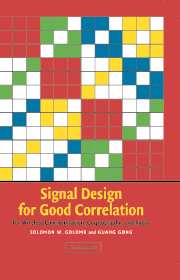Book contents
- Frontmatter
- Contents
- Preface
- Acknowledgments
- Historical Introduction
- 1 General Properties of Correlation
- 2 Applications of Correlation to the Communication of Information
- 3 Finite Fields
- 4 Feedback Shift Register Sequences
- 5 Randomness Measurements and m-Sequences
- 6 Transforms of Sequences and Functions
- 7 Cyclic Difference Sets and Binary Sequences with Two-Level Autocorrelation
- 8 Cyclic Hadamard Sequences, Part 1
- 9 Cyclic Hadamard Sequences, Part 2
- 10 Signal Sets with Low Crosscorrelation
- 11 Correlation of Boolean Functions
- 12 Applications to Radar, Sonar, Synchronization, and CDMA
- Bibliography
- Index
5 - Randomness Measurements and m-Sequences
Published online by Cambridge University Press: 15 August 2009
- Frontmatter
- Contents
- Preface
- Acknowledgments
- Historical Introduction
- 1 General Properties of Correlation
- 2 Applications of Correlation to the Communication of Information
- 3 Finite Fields
- 4 Feedback Shift Register Sequences
- 5 Randomness Measurements and m-Sequences
- 6 Transforms of Sequences and Functions
- 7 Cyclic Difference Sets and Binary Sequences with Two-Level Autocorrelation
- 8 Cyclic Hadamard Sequences, Part 1
- 9 Cyclic Hadamard Sequences, Part 2
- 10 Signal Sets with Low Crosscorrelation
- 11 Correlation of Boolean Functions
- 12 Applications to Radar, Sonar, Synchronization, and CDMA
- Bibliography
- Index
Summary
Randomness of a sequence refers to the unpredictablity of the sequence. Any deterministically generated sequence used in practical applications is not truly random. The best that can be done here is to single out certain properties as being associated with randomness and to accept any sequence that has these properties as random or more properly, a pseudorandom sequence. In this chapter, we will discuss the randomness of sequences whose elements are taken from a finite field. In Section 5.1, we present Golomb's three randomness postulates for binary sequences, namely the balance property, the run property, and the (ideal) two-level autocorrelation property, and the extension of these randomness postulates to nonbinary sequences. M-sequences over a finite field possess many extraordinary randomness properties except for having the lowest possible linear span, which has stimulated researchers to seek nonlinear sequences with similarly such favorable properties for years. In Section 5.2, we show that m-sequences satisfy Golomb's three randomness postulates. In Section 5.3, we introduce the interleaved structures of m-sequences and the subfield decomposition of m-sequences. In Sections 5.4–5.6, we present the shift-and-add property, constant-on-cosets property, and 2-tuple balance property of m-sequences, respectively. The last section is devoted to the classification of binary sequences of period 2n − 1.
Golomb's randomness postulates and randomness criteria
We discussed some general properties of auto- and crosscorrelation in Chapter 1 for sequences whose elements are taken from the real number field or the complex number field.
Information
- Type
- Chapter
- Information
- Signal Design for Good CorrelationFor Wireless Communication, Cryptography, and Radar, pp. 117 - 161Publisher: Cambridge University PressPrint publication year: 2005
